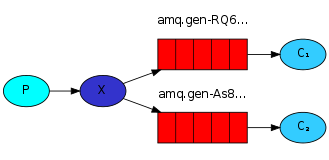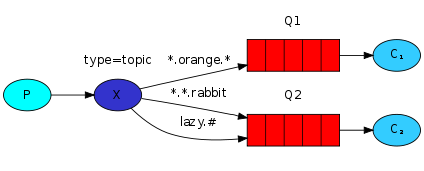-
基本用法流程
- 生产者:
- 建立socket连接上rabbitmq
1 connection = pika.BlockingConnection(pika.ConnectionParameters(host='localhost'))
1 pika.ConnectionParameters(host=_DEFAULT, port=_DEFAULT, virtual_host=_DEFAULT, credentials=_DEFAULT, channel_max=_DEFAULT, frame_max=_DEFAULT, heartbeat=_DEFAULT, ssl=_DEFAULT, ssl_options=_DEFAULT, connection_attempts=_DEFAULT, retry_delay=_DEFAULT, socket_timeout=_DEFAULT, locale=_DEFAULT, backpressure_detection=_DEFAULT, blocked_connection_timeout=_DEFAULT, client_properties=_DEFAULT, tcp_options=_DEFAULT, **kwargs)- 常用参数
- host,与rabbitmq服务器连接,设置为localhost表示与本机的rabbitmq建立连接,通常程序与rabbitmq服务需要在统一环境方可使用
- port,默认5672
- credentials:用户认证,使用如
pika.credentials.PlainCredentials进行认证
- 常用参数
- 建立通信通道
channel = connection.channel()
- 建立队列/建立交换机
- 简单模式建立队列
result = channel.queue_declare(self, queue='', passive=False, durable=False, exclusive=False, auto_delete=False, arguments=None)- 常用参数
- queue,队列名
- durable,消息是放在队列由消费者取走,该参数表示取走时是否备份一份
- exclusive,队列是否本连接独占
- 建立的队列
queue = result.method.queue
- 常用参数
- 其他模式建立交换机
channel.exchange_declare(exchange=None, exchange_type='direct', passive=False, durable=False, auto_delete=False, internal=False, arguments=None)
- 常用参数
- exchange,交换机名称
- exchange_type,重点,交换机的模式,有三种:fanout,direct,topic,详细见exchange模式
- durable,该参数表示消费者取走时是否备份一份
- 常用参数
- 简单模式建立队列
- 传输数据
channel.basic_publish(exchange, routing_key, body, properties=None, mandatory=False, immediate=False)
- 常用参数
- exchange,传输到交换机的名,可为’‘,表示不传输到交换机
- routing_key,传输到队列的名,可为’‘,表示不传输到队列
- body,传输的数据properties,额外参数,必须是pika.BasicProperties的实例
pika.BasicProperties(content_type=None, content_encoding=None, headers=None, delivery_mode=None, priority=None, correlation_id=None, reply_to=None, expiration=None, message_id=None, timestamp=None, type=None, user_id=None, app_id=None, cluster_id=None)
- delivery_mode,传输模式
-
-
- 设置为2,表示对消息进行持久化
- reply_to,传递队列,可用于RPC回调队列
- correlation_id,关联ID,可用于RPC回调时识别身份
-
- 常用参数
- 结束
connection.close()
- 建立socket连接上rabbitmq
- 消费者
- 建立socket连接上rabbitmq
- 同上生产者
- 建立通信通道
channel = connection.channel()
- 建立交换机[可选]
- 同上生产者
- 建立队列
- 同上生产者
- 定制消息处理规则
- 定义回调函数
def callback(ch, method, properties, body): pass
- 定制规则
channel.basic_consume(consumer_callback, queue, no_ack=False, exclusive=False, consumer_tag=None, arguments=None)- consumer_callback,回调函数
- queue,接收消息队列
- no_ack,是否不应答,True表示不应答,False表示应答
- 是否给rabbitmq返回,已收到并处理消息
- 定义回调函数
- 阻塞监听队列,当有消息,则按照规则处理
channel.start_consuming()
- 建立socket连接上rabbitmq
RabbitMQ工作模型
- 工作模型指的是生产者和消费者之间使用不同规则通信使用的RabbitMQ的模式
简单模式

- 示例
-
生产者
1 import pika 2 3 # 封装socket通信,建立连接 4 connection = pika.BlockingConnection( 5 pika.ConnectionParameters( 6 host='192.168.40.128', 7 port=5672, 8 credentials=pika.credentials.PlainCredentials( 9 username='admin', 10 password='123456' 11 ) 12 )) 13 14 # 创建通道对象 15 channel = connection.channel() 16 17 # 创建一个队列,名字为hello 18 channel.queue_declare(queue='hello') 19 20 # 直接向队列推送消息 21 msg = "兔子" 22 num = 10 23 for i in range(num): 24 channel.basic_publish( 25 exchange='', # 值为空表示简单模式 26 routing_key='hello', # 队列名 27 body=''.join([msg, str(i)]) # 发送数据 28 ) 29 30 print("Sent '%s' * %s" % (msg, num)) 31 connection.close()
-
消费者
1 import pika 2 3 # 封装socket通信,建立连接 4 connection = pika.BlockingConnection( 5 pika.ConnectionParameters( 6 host='192.168.40.128', 7 port=5672, 8 credentials=pika.credentials.PlainCredentials( 9 username='admin', 10 password='123456' 11 ) 12 )) 13 14 # 创建通道对象 15 channel = connection.channel() 16 17 # 创建一个叫hello的队列,有则连接该队列 18 channel.queue_declare(queue='hello') 19 20 # 定义回调函数 21 def callback(ch, method, properties, body): 22 print(" [x] Received %r" % body.decode("utf-8")) 23 24 # 设置执行命令 25 channel.basic_consume( 26 callback, 27 queue='hello', 28 no_ack=True 29 ) 30 31 print(' [*] Waiting for messages. To exit press CTRL+C') 32 # 执行命令 33 channel.start_consuming()
-
exchange模式(三种)
fanout
- 分发模式,报纸订阅模式,生产者生产一份数据,交换机为每个消费者绑定的队列发送一样的数据

-
生产者
1 import pika 2 import sys 3 4 connection = pika.BlockingConnection(pika.ConnectionParameters(host='localhost')) 5 channel = connection.channel() 6 7 channel.exchange_declare(exchange='logs', 8 exchange_type='fanout') 9 10 message = ' '.join(sys.argv[1:]) or "info: Hello World!" 11 channel.basic_publish(exchange='logs', 12 routing_key='', 13 body=message) 14 print(" [x] Sent %r" % message) 15 connection.close()
-
消费者
1 import pika 2 3 connection = pika.BlockingConnection(pika.ConnectionParameters(host='localhost')) 4 channel = connection.channel() 5 6 channel.exchange_declare(exchange='logs', 7 exchange_type='fanout') 8 9 result = channel.queue_declare(exclusive=True) 10 queue_name = result.method.queue 11 12 channel.queue_bind(exchange='logs', 13 queue=queue_name) 14 15 print(' [*] Waiting for logs. To exit press CTRL+C') 16 17 def callback(ch, method, properties, body): 18 print(" [x] %r" % body) 19 20 channel.basic_consume(callback, 21 queue=queue_name, 22 no_ack=True) 23 24 channel.start_consuming()
direct
- 关键字指定发送,

-
生产者
1 import pika 2 import sys 3 4 connection = pika.BlockingConnection(pika.ConnectionParameters(host='localhost')) 5 channel = connection.channel() 6 7 channel.exchange_declare(exchange='direct_logs', 8 exchange_type='direct') 9 10 severity = sys.argv[1] if len(sys.argv) > 2 else 'info' 11 message = ' '.join(sys.argv[2:]) or 'Hello World!' 12 channel.basic_publish(exchange='direct_logs', 13 routing_key=severity, 14 body=message) 15 print(" [x] Sent %r:%r" % (severity, message)) 16 connection.close()
-
消费者
 View Code
View Code1 import pika 2 import sys 3 4 connection = pika.BlockingConnection(pika.ConnectionParameters(host='localhost')) 5 channel = connection.channel() 6 7 channel.exchange_declare(exchange='direct_logs', 8 exchange_type='direct') 9 10 result = channel.queue_declare(exclusive=True) 11 queue_name = result.method.queue 12 13 severities = sys.argv[1:] 14 if not severities: 15 sys.stderr.write("Usage: %s [info] [warning] [error] " % sys.argv[0]) 16 sys.exit(1) 17 18 for severity in severities: 19 channel.queue_bind(exchange='direct_logs', 20 queue=queue_name, 21 routing_key=severity) 22 23 print(' [*] Waiting for logs. To exit press CTRL+C') 24 25 def callback(ch, method, properties, body): 26 print(" [x] %r:%r" % (method.routing_key, body)) 27 28 channel.basic_consume(callback, 29 queue=queue_name, 30 no_ack=True) 31 32 channel.start_consuming()
-
测试
python producer.py warning error > logs_from_rabbit.logpython comsumer.py info warning error
topic

-
生产者
 View Code
View Code1 import pika 2 import sys 3 4 connection = pika.BlockingConnection(pika.ConnectionParameters(host='localhost')) 5 channel = connection.channel() 6 7 channel.exchange_declare(exchange='topic_logs', 8 exchange_type='topic') 9 10 routing_key = sys.argv[1] if len(sys.argv) > 2 else 'anonymous.info' 11 message = ' '.join(sys.argv[2:]) or 'Hello World!' 12 channel.basic_publish(exchange='topic_logs', 13 routing_key=routing_key, 14 body=message) 15 print(" [x] Sent %r:%r" % (routing_key, message)) 16 connection.close()
-
消费者
 View Code
View Code1 import pika 2 import sys 3 4 connection = pika.BlockingConnection(pika.ConnectionParameters(host='localhost')) 5 channel = connection.channel() 6 7 channel.exchange_declare(exchange='topic_logs', 8 exchange_type='topic') 9 10 result = channel.queue_declare(exclusive=True) 11 queue_name = result.method.queue 12 13 binding_keys = sys.argv[1:] 14 if not binding_keys: 15 sys.stderr.write("Usage: %s [binding_key]... " % sys.argv[0]) 16 sys.exit(1) 17 18 for binding_key in binding_keys: 19 channel.queue_bind(exchange='topic_logs', 20 queue=queue_name, 21 routing_key=binding_key) 22 23 print(' [*] Waiting for logs. To exit press CTRL+C') 24 25 def callback(ch, method, properties, body): 26 print(" [x] %r:%r" % (method.routing_key, body)) 27 28 channel.basic_consume(callback, 29 queue=queue_name, 30 no_ack=True) 31 32 channel.start_consuming()
-
测试
- 接收所有日志
python comsumer.py "#"
- 接收包含kern开头的
python comsumer.py "kern.*"
- 接收critical结尾的
python comsumer.py "*.critical"
- 发送kern.critical、A critical kernel error
python producer.py "kern.critical" "A critical kernel error"
- 接收所有日志
基于RabbitMQ的RPC
- 何为RPC
- 客户端通过消息队列向服务端发送数据
- 服务端处理完数据,将数据通过回调队列返回给客户端
- 客户端可能回同时发起多个任务,在服务端回调后应当根据唯一标识为每一个任务返回值的指定数据

-
服务端
 View Code
View Code1 import pika 2 3 connection = pika.BlockingConnection(pika.ConnectionParameters(host='localhost')) 4 5 channel = connection.channel() 6 7 channel.queue_declare(queue='rpc_queue') 8 9 def fib(n): 10 if n == 0: 11 return 0 12 elif n == 1: 13 return 1 14 else: 15 return fib(n-1) + fib(n-2) 16 17 def on_request(ch, method, props, body): 18 n = int(body) 19 20 print(" [.] fib(%s)" % n) 21 response = fib(n) 22 23 ch.basic_publish(exchange='', 24 routing_key=props.reply_to, 25 properties=pika.BasicProperties(correlation_id = 26 props.correlation_id), 27 body=str(response)) 28 ch.basic_ack(delivery_tag = method.delivery_tag) 29 30 channel.basic_qos(prefetch_count=1) 31 channel.basic_consume(on_request, queue='rpc_queue') 32 33 print(" [x] Awaiting RPC requests") 34 channel.start_consuming()
-
客户端
 View Code
View Code1 import pika 2 import uuid 3 4 class FibonacciRpcClient(object): 5 def __init__(self): 6 self.connection = pika.BlockingConnection(pika.ConnectionParameters(host='localhost')) 7 8 self.channel = self.connection.channel() 9 10 result = self.channel.queue_declare(exclusive=True) 11 self.callback_queue = result.method.queue 12 13 self.channel.basic_consume(self.on_response, no_ack=True, 14 queue=self.callback_queue) 15 16 def on_response(self, ch, method, props, body): 17 if self.corr_id == props.correlation_id: 18 self.response = body 19 20 def call(self, n): 21 self.response = None 22 self.corr_id = str(uuid.uuid4()) 23 self.channel.basic_publish(exchange='', 24 routing_key='rpc_queue', 25 properties=pika.BasicProperties( 26 reply_to = self.callback_queue, 27 correlation_id = self.corr_id, 28 ), 29 body=str(n)) 30 while self.response is None: 31 self.connection.process_data_events() 32 return int(self.response) 33 34 fibonacci_rpc = FibonacciRpcClient() 35 36 print(" [x] Requesting fib(30)") 37 response = fibonacci_rpc.call(30) 38 print(" [.] Got %r" % response)
